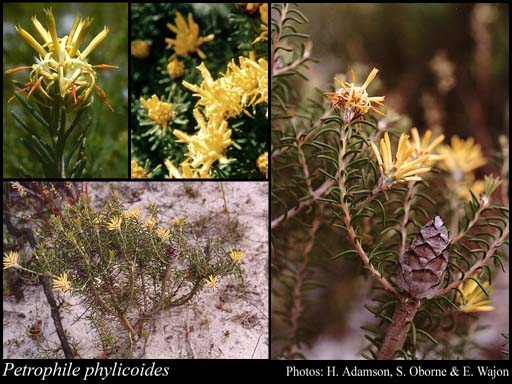- Reference
- Suppl.Prodr.Fl.Nov.Holl. 6 (1830)
- Conservation Code
- Not threatened
- Naturalised Status
- Native to Western Australia
- Name Status
- Current
Compact, non-lignotuberous shrub, 0.2-1(-1.75) m high. Fl. yellow/cream-yellow, Sep to Dec. White, grey or brown sand, often with gravel. Sandplains, lateritic ridges.

Scientific Description
Shrubs, 1-1.5 m high; branchlets glabrous. Leaves alternate, 8-15 mm long, 1-1.2 mm wide, glabrous; lamina terete, entire, straight or curved, smooth, apex acute, 0.2-0.5 mm long. Inflorescences not viscid, cream or yellow. Perianth 10-12 mm long, glabrous; pistil 10-12 mm long; pollen presenter fusiform, hairy, 4-5.5 mm long. Cone with persistent scales, 25-28 mm long. Flowers in September, October, November or December. Occurs in the Eremaean (ER) or South-west (SW) Botanical Province(s), in the Coolgardie (COO), Avon Wheatbelt (AW), Jarrah Forest (JF), Mallee (MAL) or Esperance Plains (ESP) IBRA subregion(s).
Distribution
- IBRA Regions
- Avon Wheatbelt, Esperance Plains, Jarrah Forest, Mallee.
- IBRA Subregions
- Eastern Mallee, Fitzgerald, Katanning, Recherche, Southern Jarrah Forest, Western Mallee.
- IMCRA Regions
- WA South Coast.
- Local Government Areas (LGAs)
- Albany, Cranbrook, Dumbleyung, Esperance, Gnowangerup, Jerramungup, Kent, Kondinin, Kulin, Lake Grace, Plantagenet, Ravensthorpe, Wickepin.